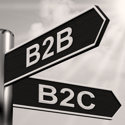
Value propositions are one of the most important contributions marketers make to the growth of their businesses. These critical promises compel customers to choose your offering over the offerings of your competitors. But how is creating a value proposition different for B2B vs. consumer businesses?
Strong value propositions are equally important in both types of business, but there are some important differences in complexity and application. Awareness of these differences can help both B2B and B2C marketers create more nuanced value propositions that move the needle on sales. While it’s hard to generalize given variations across industries and products, here are some key differences to be aware of.
Customer Definition
- B2B. Business customers have multiple roles involved in the purchase and use of products and services. There are gatekeepers, influencers, decision-makers and approvers—none of which may be the actual users. The value proposition must be able to stretch and morph to appeal to this multi-headed buying unit.
- B2C. In most consumer businesses, the target consumer is an individual or a household. Whether marketing a bar of soap or a holiday destination, marketers deal with either the shopper or the individual/household user.
Customer Value
- B2B. Business value propositions generally place a stronger emphasis on the financial value of their offering. Appeal increases based on the strength and clarity of the offering’s case for uniquely helping a business reduce costs and/or grow revenues. Emotion still matters. Trust, peace of mind, ease of doing business are all relevant emotional drivers of business purchases, but the emphasis remains with the unique economic value of the offering. (This is where the powerful and compelling Quantified Value Proposition comes into the mix: with the right approach and skillful application, there is no better way to appeal to a financially-focused B2B buyer.)
- B2C. The promise of value is typically a combination of a functional benefit (e.g., cleaning efficacy, time-saving) and emotional benefit (e.g., home pride, peace of mind). The emphasis is on uniquely delivering the emotional benefit through the functionality of the product/service.
Value Chain
- B2B. B2B companies may have a far more complex value chain with multiple channel partners involved. B2B marketers have to create multi-step value propositions that appeal to the different entities in the value chain. For example, a new medical procedure needs to have a value proposition that appeals not just to patients but also to physicians, hospitals and payers.
- B2C. Consumer businesses usually go to market through a relatively simple 1-2 step value chain.
It takes effort and skill to create compelling value propositions in any kind of business, and we believe B2B and B2C marketers have a lot to learn from each other. While consumer marketers can learn a lot from B2B marketers on how to address shoppers and influencers, B2B marketers can learn a lot about how to embed emotional appeal into their value propositions.
Especially for B2B marketers, the creation of a Quantified Value Proposition (QVP) ranks among the most important skill sets needed to remain competitive today.


